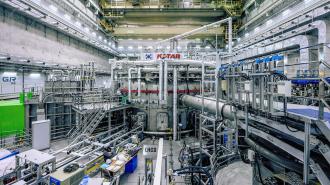An upgrade to Korea’s “artificial sun” enabled scientists to set a new world record in nuclear fusion research — putting us a step closer to harnessing the power of fusion to generate clean energy.
Nuclear fusion 101: Inside the sun’s core, hydrogen atoms slam into one another so fast and under such high temperature and pressure that they merge. This is nuclear fusion, and the energy it releases in the form of heat is what powers the sun and other stars.
If we could harness nuclear fusion here on Earth, we’d have a theoretically near-limitless supply of clean energy, but we need to recreate the conditions of the sun’s core — and that is a huge engineering challenge.
To get more energy out of fusion reactors than we put into them, we need to be able to sustain super-hot plasma for longer.
An artificial sun: One device designed to do this is called a “tokamak.” This donut-shaped machine generates enough heat and pressure to turn gaseous hydrogen fuel into a plasma. Magnetic fields then confine the plasma in a way that allows fusion to take place within it.
While scientists have managed to trigger nuclear fusion using tokamaks, they’re still working on extending how long we can sustain the super-hot plasma — that is absolutely crucial to getting more energy out of our fusion reactors than we put into them.
What’s new? In 2021, researchers at the Korea Institute of Fusion Energy (KFE) set a new world record by sustaining plasma at a temperature of 100 million degrees Celsius for 30 seconds using their Korea Superconducting Tokamak Advanced Research (KSTAR) device.
They’ve now broken the record again, sustaining plasma at 100 million degrees for 48 consecutive seconds, during a testing campaign that ran from December 2023 to February 2024.
How it works: In 2023, KSTAR was upgraded with a new diverter. This device is located at the bottom of a tokamak, and it plays an important role in a fusion reactor, extracting heat and ash, helping prevent plasma contamination, and more.
KSTAR used to have a carbon-based diverter, but the new one contains tungsten, a metal that is better able to withstand the heat, and it didn’t take long for KFE scientists to see its benefit.
“Despite being the first experiment run in the environment of the new tungsten [diverter], thorough hardware testing and campaign preparation enabled us to achieve results surpassing those of previous KSTAR records in a short period,” said KSTAR Director Si-Woo Yoon.
Looking ahead: Korea built KSTAR to test technologies for the International Thermonuclear Experimental Reactor (ITER), a huge tokamak currently under construction in France. Once that tokamak is up and running, it will be the largest nuclear fusion device in the world, and the hope is that it’ll be the bridge between fusion research and fusion power plants.
Korea is one of seven core members of the ITER project, and since tungsten has been chosen for ITER’s diverter, it made sense to use the material at KSTAR, too. Now, the KFE team will have the opportunity to collect more data that could help ensure the success of ITER — and bring us closer to a future powered by clean energy.
We’d love to hear from you! If you have a comment about this article or if you have a tip for a future Freethink story, please email us at [email protected].






